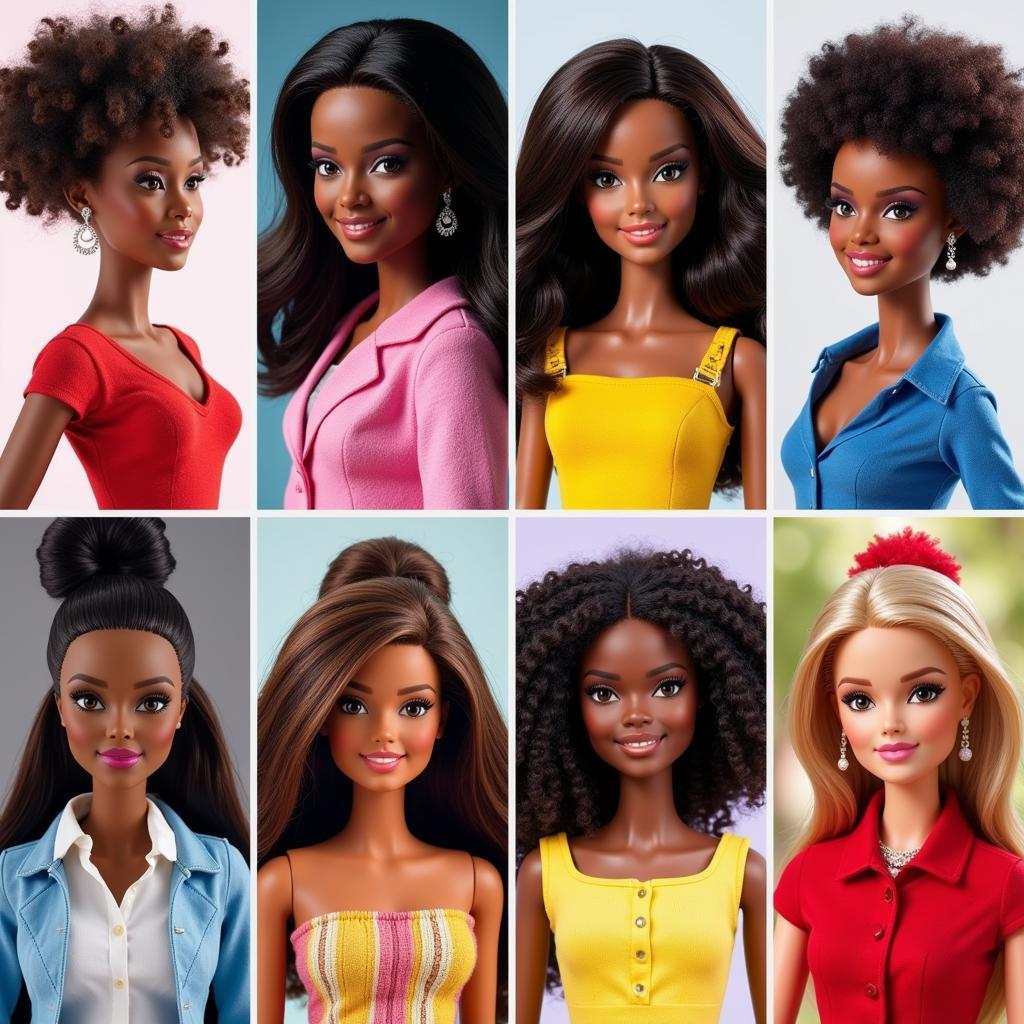Exploring the Significance of African American Ken and Barbie Dolls
The African American Ken and Barbie doll collection represents a significant shift in the toy industry, reflecting a growing awareness and appreciation for diversity and inclusion. These dolls aren’t just toys; they’re powerful symbols of representation for children of color, offering a reflection of themselves in the toys they play with. From their inception to their evolution, these dolls offer a fascinating glimpse into changing societal norms and the power of representation.
A Journey Through Time: The Evolution of African American Ken and Barbie
The first African American Barbie doll, Christie, was introduced in 1968, marking a crucial step towards inclusivity. However, it wasn’t until 1980 that the first official African American Barbie and Ken dolls were released. These dolls weren’t just variations in skin tone; they represented a conscious effort to portray Black features, hairstyles, and fashion. Over the decades, Mattel has continued to expand its line of Black Barbies and Kens, showcasing a wider range of skin tones, hair textures, and body types. This evolution reflects a growing understanding of the diversity within the Black community and a commitment to creating dolls that resonate with a broader audience.
 African American Ken and Barbie Dolls Through the Years
African American Ken and Barbie Dolls Through the Years
The Impact of Representation: Why These Dolls Matter
For many Black children, seeing themselves reflected in their toys can be a profoundly impactful experience. African American Ken and Barbie dolls offer a sense of belonging and validation, reinforcing their identity and promoting self-esteem. These dolls allow children to envision themselves in various roles and professions, fostering imagination and inspiring future aspirations. Moreover, these dolls contribute to a more inclusive play environment, teaching children of all backgrounds about the beauty of diversity and the importance of representation.
Dr. Anika Johnson, a child psychologist specializing in cultural identity development, emphasizes this point: “Toys are not just playthings; they are tools that shape a child’s understanding of themselves and the world around them. Having dolls that reflect their own image can significantly impact a child’s self-worth and sense of belonging.”
More Than Just Toys: Celebrating Black Culture and Heritage
Beyond representation, African American Ken and Barbie dolls also provide an opportunity to celebrate Black culture and heritage. From traditional African attire to contemporary fashion inspired by Black designers, these dolls showcase the richness and diversity of Black aesthetics. Some dolls even highlight significant figures in Black history, inspiring children to learn more about their heritage and the contributions of Black individuals to society.
What is the significance of African American Ken and Barbie dolls?
These dolls offer crucial representation for Black children, fostering self-esteem and a sense of belonging.
Where can I find a diverse range of African American Ken and Barbie dolls?
Major retailers and online marketplaces offer a variety of options to choose from.
Beyond the Dolls: Promoting Inclusivity in Playtime
The importance of diverse representation extends beyond just dolls. Creating a truly inclusive play environment involves incorporating toys and activities that reflect a wide range of cultures and experiences. This can include books, games, and puzzles that feature characters from different backgrounds, encouraging children to learn about and appreciate the world’s diverse cultures.
Professor Kwame Asante, a cultural anthropologist specializing in African studies, adds: “By exposing children to a diverse range of toys and play experiences, we can foster empathy, understanding, and respect for different cultures, laying the foundation for a more inclusive society.”
 Diverse Toys and Activities Promoting Inclusive Play
Diverse Toys and Activities Promoting Inclusive Play
Conclusion: Embracing Diversity and Empowering Future Generations
The African American Ken and Barbie doll collection represents a significant stride towards creating a more inclusive and representative toy industry. These dolls not only provide a powerful symbol of representation for Black children but also offer an opportunity for children of all backgrounds to learn about and appreciate the beauty of diversity. By embracing inclusivity in playtime, we can empower future generations to build a more just and equitable world. The African American Ken and Barbie doll, a symbol of representation, continues to evolve and inspire.
FAQ
- When was the first African American Barbie released? The first official African American Barbie was released in 1980.
- Why is representation in toys important? Representation fosters self-esteem and a sense of belonging in children.
- How have African American Ken and Barbie dolls evolved over time? They have evolved to showcase a wider range of skin tones, hair textures, and body types.
- Where can I find more information about the history of these dolls? Mattel’s official website and various online resources offer detailed information.
- How can I create a more inclusive play environment for my child? Incorporate diverse toys, books, and activities that represent various cultures.
- What other dolls celebrate diversity? Many doll brands now offer dolls representing various ethnicities and cultures.
- How do these dolls contribute to cultural understanding? They expose children to diverse aesthetics and inspire them to learn about Black culture.
For further insights into African culture, explore our article on african animals video youtube.
Need help finding the perfect doll? Explore our collection of articles about dolls from diverse cultures.
When you need assistance, please contact us: Phone: +255768904061, Email: kaka.mag@gmail.com or visit us at: Mbarali DC Mawindi, Kangaga, Tanzania. We have a 24/7 customer service team.
